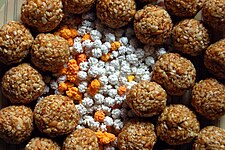| This article includes a list of references, related reading, or external links, but its sources remain unclear because it lacks inline citations. Please help improve this article by introducing more precise citations. (March 2013) (Learn how and when to remove this message) |
 | |
| Course | Dessert |
|---|---|
| Place of origin | India |
| Region or state | Maharashtra |
| Main ingredients | Sesame seeds, jaggery |
Tilgul is an Indian jaggery and sesame candy coated with sesame seeds. In the state of Maharashtra, people exchange tilgul on Sankranti, a Hindu festival celebrated on 14 January, which continues for seven days till Rath Saptami.
Sesame and jaggery are both warming foods that can help boost immunity. This candy is thus beneficial for the human body during the winter season. Hence this candy is consumed during winter festivals like Sankranti and Lohri.
The sweet is a mixture of sesame seeds (called "Til" in Marathi) and jaggery (called "Gul" in Marathi), hence the name. On Sankranti eve, families serve their guests Tilgul or Tilgul sweets while saying "Tilgul ghya, goad goad bola" which literally means "Take Tilgul and talk sweetly".
See also
External links
References
- ^ "Healthy eating: This is what makes til-gul the ultimate winter combination". The Indian Express. 2023-01-23. Retrieved 2023-12-30.
This Indian dessert-related article is a stub. You can help Misplaced Pages by expanding it. |